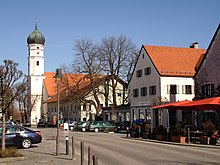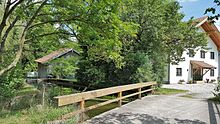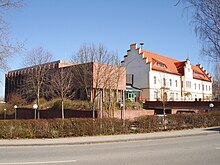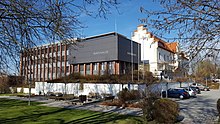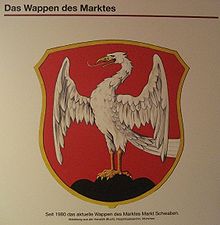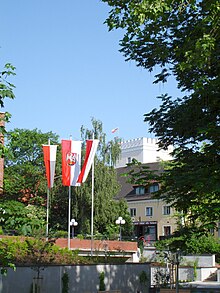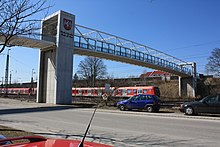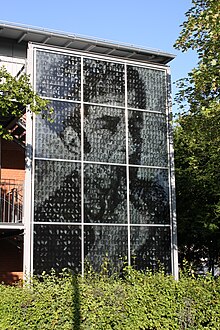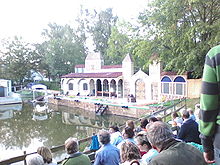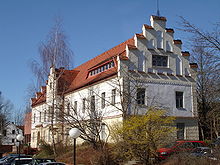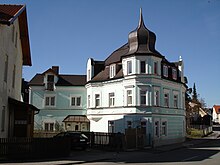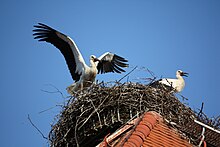Market Swabia
| coat of arms | Germany map | |
|---|---|---|

|
Coordinates: 48 ° 12 ' N , 11 ° 52' E |
|
| Basic data | ||
| State : | Bavaria | |
| Administrative region : | Upper Bavaria | |
| County : | Ebersberg | |
| Height : | 509 m above sea level NHN | |
| Area : | 10.86 km 2 | |
| Residents: | 13,818 (Dec 31, 2019) | |
| Population density : | 1272 inhabitants per km 2 | |
| Postal code : | 85570 | |
| Area code : | 08121 | |
| License plate : | EBE | |
| Community key : | 09 1 75 127 | |
| LOCODE : | DE MSN | |
Market administration address : |
Schloßplatz 2 85570 Markt Schwaben |
|
| Website : | ||
| Mayor : | Michael Stolze ( SPD ) | |
| Location of the Markt Schwaben market in the Ebersberg district | ||
Markt Schwaben is a market on the northern border of the Upper Bavarian district of Ebersberg .
geography
location
Markt Schwaben is located north of the Ebersberger Forest in the Munich gravel plain, not far from the headwaters of the Sempt and the Ismaninger reservoir . The community is conveniently located around 25 km east of the state capital Munich , 14 km south of Erding , 28 km west of Haag and 15 km north of the district town of Ebersberg . For Munich Airport is 30 km away. Markt Schwaben has an important train station with a connection to the S-Bahn and Regional-Express / Regionalbahn as well as a good connection to the A 94 .
The Hennigbach (formerly Honigbach) flows through the village, into which the Gigginger Bach flows southwest of Markt Schwaben. On the Hennigbach there are frequent floods, which in the past also led to major damage. So at the beginning of September 1920, in the 1990s and in July 2013. A large area of the banks of the Hennigbach was therefore renatured and expanded into a local recreation and flooding area, the Postanger. Further measures are planned. The Sempt flows past to the east of Markt Schwaben . The highest point of the village is the Wittelsbacher Höhe ( 539 m ) on the southern edge of the village. The sports center with the swimming pond is also to the south. To the north of the railroad tracks are the new Burgerfeld development area with a theater hall, further residential areas and two industrial areas. The remaining part of the former castle with the town hall, the market square and the Catholic parish church of St. Margaret are located in the center of the village, the school center adjoins it to the southwest.
There are also some mills and two fisheries in the east along the Sempt . The hamlets of Feichten and the desert areas of Hanslmühle, Haus, Paulimühle, Sägmühle and Staudham belong to Markt Schwaben.
Although Markt Schwaben is the fourth largest municipality in the district in terms of population, it is the smallest of the Ebersberg municipalities in terms of area.
Neighboring communities
history
The history of Markt Schwaben can be traced back to the 12th century. The place got its name from settlers from the Alemannic Suaben . In 1115 the knight Ulrich von Moosach gave a mill near Suaben and two serfs to the church, for the salvation of his uncle Rupert I , abbot of the Ebersberg monastery. This document is the first written mention of the place Swabia. The mill mentioned at that time is probably the kressier mill that still exists today . It was the only mill on the Sempt that was owned by the monastery until secularization .
At first, Swabia was owned by the Count of Ebersberg , then by the Count of Limburg-Wasserburg, until it finally became the property of the Wittelsbach family in 1247 . The administration took over the office Falkenberg near Moosach . When the gentry and ministerial family died out in 1272, Swabia fell back to the Wittelsbach family.
In 1340 Swabia was finally granted market rights by Duke Rudolf. By market conformity and village jurisdiction of the city continued to flourish and eventually put the seat of a district court - in the Electoral Palace -. 1805 represents the last sentence was a blood court imposed, after two Grafingerstraße killer in "gallows Hölzl" were beheaded. The district court was moved to Ebersberg in 1811, which caused the place to suffer and threatened to sink into insignificance.
When the Bavarian state was divided in 1392 , Swabia became part of the partial duchy of Bavaria-Ingolstadt under Duke Stephan III. In 1394 the Munich Swabians plundered. All the documents that documented all privileges and rights were burned. In 1397, Swabia was pledged to Vitztum Konrad Preysinger , chief ministerial officer of Upper Bavaria-Munich, for 5000 Hungarian guilders . Just six years later, Swabia went back to the Duke. During these years, the citizens of Swabia tried several times to persuade the duke to confirm their old rights in documents. Finally, Duke Stephan III signed. on the Friday before White Sunday in Wasserburg three "letters" with almost identical text. In these Swabians the market law, the right to exercise lower jurisdiction and the right to use a coat of arms were confirmed:
"... Your rights and the grace of freedom that you had received from the hand of the ruler of Bavaria, documented by documents, have been burned ... So we have taken care of your poverty and requests."
“By special grace we give them a seal and banner, which they did not have until now, by virtue of this letter for ever. The freedom that Ingolstadt and other cities and markets have, they should enjoy undisturbed ... The coat of arms is a white falcon on a black mountain with rising wings in a red field. "
"... So that there are no legal disputes, I command all my officials, carers, judges and henchmen ... to protect and shield them with this coat of arms ... My certificate with my seal for confirmation ..."
After the death of Ludwig VII , the last Duke of Bavaria-Ingolstadt, Duke Heinrich XVI occupied. from Bavaria-Landshut a large part of Upper Bavaria on the Danube and northern Lech . Duke Albrecht III. only the Swabian nursing court was able to secure itself through negotiations for Bavaria-Munich in the Erdinger Treaty of 1450 .
On May 5th, 1749, there was a major fire when a lieutenant in French service was playing around with fireworks in the Wagner smithy. Half of the market square with 33 houses and two barns burned down. The lieutenant had to forego his entire inheritance as compensation.
When American troops advanced towards Markt Schwaben at the end of April 1945, the Wehrmacht and SS had already left the place. The NSDAP local group leader had also fled. So that the goods in the depots did not fall into the hands of the Americans, the mayor had the warehouses opened to the public. The residents of Markt Schwaben then used it to hamster balls of cloth, boots, leather and liters of schnapps. On the morning of May 1st, US troops occupied the site without incident. The Markt Schwabener Lorenz Ostermayr , who had once lived in New York, ran towards the enemy with a white flag and three prisoners of war and informed the Americans that there were no more German troops in Markt Schwaben. Coincidentally, the American tank commander came from the same street in New York where Ostermayr had lived.
About 50 former Jewish concentration camp prisoners gathered in the market square on the same day . On April 25, they escaped from a train in Poing that was supposed to bring them from the Mühldorf satellite camp in the direction of Tyrol . In the last days of the war, the Schwaben doctor Fritz Lichtenegger had set up an auxiliary hospital in Unterbräu, to which the emaciated refugees were now taken. Some of them still died in the weeks that followed.
The American soldiers searched the place house by house. In barracks, which were originally intended to house French prisoners of war, the Americans found the personnel records of the engineers who were involved in the development of the V2 . An SS uniform was discovered at the doctor's house, Lichtenegger, whereupon, after a short trial, he was executed by the Americans.
After the Second World War , many expellees from the former German eastern regions settled in Markt Schwaben. Street names such as Königsberger , Neusatzer or Ödenburger Straße in the southwest of Markt Schwaben remind of this. During this time, the population consisted mainly of typically down-to-earth traders who supplied the market and the surrounding villages with products. Many streets were named in memory of them when the town was given street names in the early 1960s (e.g. Weißgerberweg, Kupferschmiedberg, Nagelschmiedgasse).
Since the municipality decided in 1922 to include the name Markt in the place name, the official name of the municipality has been Markt Markt Schwaben since December 7, 1922 . Under Prime Minister Wilhelm Hoegner (SPD), some markets were elevated to cities in 1954, including Grafing and Ebersberg . The word “market” in the place name prevented it from becoming a town.
In the 1960s there was a building boom in Markt Schwaben, as everywhere in the Munich catchment area, which resulted in two high-rise developments (von-Kobell-Straße and Dr.-Hartlaub-Ring). On postcards from that time, the place is accordingly referred to as a “residential area in the east of Munich”.
In May 1962 the reconnaissance aircraft Navy 131390 crashed , large parts of the aircraft hit a field near the Löfflmühle near Markt Schwaben. Since May 2012 a memorial plaque has been commemorating the unexplained accident.
A short sequence of the film Busted Chains was shot in Markt Schwaben in 1962. James Coburn alias Officer Louis Sedgwick steals a bicycle in front of the old town hall on the market square and then drives away down Ebersberger Straße.
The connection to the Munich local transport network for the Olympic Summer Games in Munich in 1972 gave the place a certain heyday, as from now on there was also a fast connection to the city of Munich in addition to the regional train. The 20-minute intervals on the S-Bahn line have existed since the mid-1990s. In 1990 the motorway connection was completed. In 1992/1993 the sports park with the bathing pond was built in the southeast of the market.
With the development of the Burgerfeld in the northwest in the 1990s, the foundation stone was laid for a new district including an expansion of the commercial area. The development is currently still ongoing. The Burgerfeld is connected to the town center by a pedestrian bridge (with a length of over 50 meters) via the tracks west of the train station and three underpasses. The official opening took place on December 17, 2007.
Population development
Between 1988 and 2018 the market grew from 8,699 to 13,605 by 4,906 inhabitants or 56.4%.
Religions
There is a Catholic and an Evangelical Lutheran church in Markt Schwaben . There are also meeting rooms for the Free Evangelical Congregation and a Turkish mosque .
Catholic Parish Church of St. Margaret and Mariahilf Chapel
In the summer of 1999, the Markt Schwabener Catholics were allowed to celebrate the so far last prime of the place.
Allegedly, the market Swabian Catholics have been sitting in the wrong church since the construction work on the parish church of St. Margaret was finished, because according to stories the construction plans of the architect Georg Zwerger der Anzinger and the Swabian church were exchanged. A conclusive indication that the story could be true is that the Anzinger Marienkirche was always planned as a pilgrimage church . Pilgrimage churches usually always have two large portals so that pilgrims can move in on one side and move out on the opposite. This is the case with the parish church of St. Margaret Markt Schwaben, whereas with the Anzinger church there is a large entrance portal at the front.
The Mariahilf Chapel on Gerstlacher Weg, built in 1720, now shines in its old splendor after extensive renovation including the property.
Evangelical Philip Church
On May 22, 1955, the evangelical Philippus Church with the vicar's apartment was inaugurated. It is located in the northeast of Markt Schwaben. In 1962 the parish vicariate became an independent parish. In 1967 the church got an organ, and in 1976 a community center was added to the church. In 1986 the two small bells (h '- gis') came from the very low bell carrier next to the church into an improvised, attached bell cage. The church was renovated in 2005, and the new community center planned by Andreas Meck was inaugurated in 2016 .
Turkish mosque
At the end of the 1990s, work began on converting the old goods hall west of the Markt Schwaben train station in Bahnhofstrasse into a prayer room, offices and meeting rooms for the Islamic community DITIB Markt Schwaben Ulu Camii . Besides the mosque in Kirchseeon , which is also administered by the DITIB , it is the only mosque in the Ebersberg district to date. The mosque was renovated from December 2017 to February 2018.
Free evangelical community
Since 2001 there has been a Free Evangelical Congregation on site . The community rooms are located in the Burgerfeld industrial park on Wiegenfeldring. In 2006 the congregation became independent, in the same year it got its own pastor. Stefan Fetzner has been the pastor of the congregation since September 2018.
Catholic Parish Church of St. Margaret
politics
Municipal council
In addition to the First Mayor, the market council has 24 other members. According to the results of the election on March 15, 2020, the municipal council has seven CSU councilors (2014: 8), the Greens (3) and the Free Voters (5) each with five seats, the SPD three seats (6) and the future market Schwaben (ZMS) three seats (2) and the FDP one seat (0).
mayor
Since he had reached the legal age limit, Mayor Georg Hohmann (SPD) did not stand for re-election in 2020. His successor was the independent candidate Michael Stolze (FW, SPD), who won the runoff election against Frank Eichner (CSU) with 67.3% (turnout: 57.4%).
| Mayor since 1945 | |
|---|---|
| Surname | Term of office |
| Anton Haas (CSU) | 1945-1948 |
| Albert Jell (SPD) | 1948-1960 |
| Balthasar Strobl (CSU, BHE ) | 1960-1972 |
| Wilhelm Haller (FW, CSU) | 1972-1990 |
| Richard Huber (CSU) | 1990-2002 |
| Bernhard Winter (SPD) | 2002-2011 |
| Georg Hohmann (SPD) | 2011-2020 |
| Michael Stolze (FW, SPD) | since 2020 |
Town twinning
badges and flags
In 1409, Duke Stephan III. of Bavaria-Ingolstadt the place the coat of arms still used today. So far it was assumed that it comes from the noble family of the Falkensteins from Flintsbach am Inn , in the south of today's district of Rosenheim . The family died out in 1272. Thus their coat of arms was "single" and could be passed on without restriction. In fact, Flintsbach now has a similar coat of arms, but the Codex Falkensteinensis shows a different version with a yellow falcon on a blue background that puts on its wings. In addition, Rosenheim did not belong to the territory of Stephan III. The local history researcher Otmar Langwadt is therefore convinced that the coat of arms comes from the ministerials of Falkenberg from today's municipality of Moosach (district of Ebersberg) .
The description of the coat of arms reads: In red on a black three-mountain, a gold-armored silver falcon. The falcon has rising wings. For the beak and the tongue, however, two color variants are used: sometimes both are golden, sometimes both are white. There is no official guideline as to which form is correct.
Before the war, a tricolor is said to have been used as the municipal flag in black, white and red . The colors were derived from the coat of arms. After 1945, no flag was flied until 1953. This year, the municipal council applied to the Upper Bavarian government to award municipal colors. In the expert opinion of December 23, 1953, it was stated that the award of the historical coat of arms would make it possible to carry a coat of arms banner . White and red were suggested as the community colors. On January 20, 1954, the municipal council decided unanimously:
"It is a stripe flag on the head of which the coat of arms is attached to a square white field."
The document of the Bavarian State Ministry of the Interior stipulated:
"The flag shows 2 stripes in the color sequence white (silver) red. In the upper part (head) - the coat of arms of the market can be added - of your choice."
However, the flags that are in use today have the color sequence red and white, which contradicts the flag approval and the resolution of the market town council at that time (see photo). Only banner and flutter flags are in use. A hoist flag in which the stripes are arranged horizontally is not in use in Markt Schwaben.
economy
traffic
Road traffic
Markt Schwaben is well connected in terms of transport. The Munich-East motorway junction (to Salzburg, Nuremberg and Stuttgart) and the Munich city limits in the east can be reached via the federal motorway 94 Munich – Passau. Coming from the east is the Markt Schwaben connection point Forstinning, from the west it is Anzing . After the completion of the Flughafenentangente Ost (FTO), which connects the motorway with Munich Airport , Markt Schwaben can also be reached from the west via the new A 94 exit Markt Schwaben-Flughafenentangente Ost – Geltinger Straße. It forms direct access to the Burgerfeld industrial park. The descent to the center remains Anzing.
railroad
The Munich – Simbach and Markt Schwaben – Erding lines run through Markt Schwaben . To the north-west of the town center is the Markt Schwaben train station , where the line to Erding branches off from the Munich – Simbach line. The Royal Bavarian State Railways put the station into operation on May 1, 1871 with the main line from Munich via Mühldorf to Simbach . With the opening of the Vizinalbahn to Erding on November 16, 1872, it became a separation station . Markt Schwaben has been a station of the Munich S-Bahn since 1972 and is integrated into the Munich Transport and Tariff Association (MVV).
Markt Schwaben is served by line S 2 from Petershausen and Altomünster via Munich to Erding, which runs to Markt Schwaben every 20 minutes and from Markt Schwaben to Erding every 20/40 minutes. The S-Bahn takes you to Munich Ostbahnhof in around 20 minutes and to Marienplatz in around 30 minutes . On the main line, regional trains run every hour from Munich main station to Mühldorf.
As part of the Erdinger Ringschluss, the railway line to Erding is to be extended to the north-west of Munich Airport . The S-Bahn line S 2 is to be extended to Freising .
Bus transport
Ten bus routes operated by the Munich Transport and Tariff Association operate in Markt Schwaben. Line 446 only runs to Ebersberg every two hours from Monday to Friday . On Saturdays and Sundays, instead of line 446, the dial-a-bus line 449 runs, which, however, continues from Markt Schwaben via Pliening to Poing. Bus route 449 runs every two hours. From Monday to Friday, the 463 bus runs from Markt Schwaben via Pliening to Poing. The bus route 469 from Markt Schwaben serves the communities of Forstern and Hohenlinden from Monday to Friday approximately every two hours. Bus route 505 connects Isen with Markt Schwaben every two hours from Monday to Friday. The call taxi 5050 runs on Saturdays and Sundays. The bus route 507 also only runs Monday to Friday from Markt Schwaben via Ottenhofen and Moosinning to Erding. Erding is also approached from Markt Schwaben by bus line 568 via Finsing approximately every hour with gaps. The call taxi 5680 operates on Saturdays. The following bus routes operate in Markt Schwaben:
- 446: Market Swabia - Anzing - Forstinning - Ebersberg
- 449: Poing - Pliening - Markt Schwaben - Anzing - Forstinning - Ebersberg (on-call bus)
- 463: Market Swabia - Pliening - Poing - Pliening - Market Swabia
- 469: Market Swabia - Forstinning - Forstern - Hohenlinden
- 505: Market Swabia - Paststetten - Forstern - Buch am Buchrain - Isen
- 507: Market Swabia - Ottenhofen - Moosinning - Oberding - Erding
- 568: Market Swabia - Finsing - Moosinning - Erding
- 4460: Poing - Pliening - Markt Schwaben - Anzing - Forstinning - Ebersberg (call taxi, one trip)
- 5050: Markt Schwaben - Paststetten - Forstern - Buch am Buchrain - Isen (call taxi)
- 5680: Markt Schwaben - Finsing - Moosinning - Erding (call taxi)
Established businesses
The large industrial park in the north-west is home to a number of larger companies, such as the specialist wholesaler Wilhelm Gienger and the headquarters of the Seidenader company , which builds machines for the pharmaceutical industry. The Schmitt concrete plant is also located north of the railway line . In the south on Ebersberger Straße is the Schweiger private brewery with the associated brewery restaurant. The store also has three petrol stations, three banks, five supermarkets and four car dealerships . There are also restaurants with regional and international cuisine, craft businesses and retail stores. The furnace house Scheuerecker has existed in Färbergasse since 1907 , now in the fourth generation. The construction company Haydn was founded in 1763 by Martin Haydn I and has been in the family's eighth generation since then.
Public facilities
State institutions
The Federal Agency for Technical Relief has a local association in Markt Schwaben with two technical trains and the specialist groups for electrical supply and blasting.
In 2006 the scientific department of the Customs Technical Examination and Training Institute (ZPLA) was established in Markt Schwaben. It is an authority of the Federal Customs Administration .
Educational institutions
Markt Schwaben is home to four schools:
- Primary school Markt Schwaben (built 1978)
- Middle school in Markt Schwaben (built in 1971 with extensions to 1972) since August 1, 2011, formerly in the middle school (elementary school) in Markt Schwaben
- Lena Christ secondary school (built 1973/74)
- Franz-Marc-Gymnasium (built 1973)
Offices
The municipal offices are located in the town hall.
Leisure and sports facilities
Sports facilities:
- Sports center with: lawn playing field, circular running tracks, two training fields (one lawn, one artificial turf), practice and gymnastics meadow, tennis facility, summer curling lanes, four bowling alleys, swimming pond and sports restaurant
- Jahnsportplatz with all-weather pitch and football field
- BSG sports field with playing field and throwing area
- Alternative sports field
- Tennis facility on Hauser Weg (club house burned down in December 2005 with subsequent closure of the facility)
- Indoor swimming pool with sauna and solarium
- Climbing center with rope climbing and bouldering facility
Culture and sights
theatre
The Markt Schwabener Weiherspiele (open-air theater) was founded in 1984 by amateur theater enthusiasts.
Another very active theater group is the Junge Bühne Markt Schwaben , which has its headquarters in the Theater im Burgerfeld . It is a theater group for young people between the ages of 15 and 25 that was founded in 2003.
museum
The Markt Schwabens local history museum is located in the former Schweiger Villa on Bahnhofsstraße, which houses exhibits from the Stone Age to the present day and has two scale models of the castle and the later electoral palace.
lock
In 1283, Duke Ludwig the Strict of Upper Bavaria built a castle on a slight hill , as the border to Lower Bavaria ran behind Swabia in the northeast . In 1650, after the strategically well-placed castle had been destroyed several times, a large, four-wing castle was built on the same spot, the south wing of which, renovated in 1908 in the neo-Gothic style, is still preserved in the town center. The rest of the palace was demolished in 1812 (east and north wings including St. Magdalenenkapelle and bridge house) and in 1969 (west wing with south-west corner) due to ailing buildings and for cost reasons. Acquisition of the castle including the property in 1967 by the municipality with the subsequent construction of the new community center / town hall, whereby the castle part was strongly aligned with the modern architecture by removing all ornate chimneys and shutters. The former moat can still be seen in the south and west.
Other structures
The modern brick building of the town hall was added to the preserved castle wing. The listed water tower opposite, which was newly restored in 2009, is striking, with its battlements, which despite its appearance does not date from the Middle Ages, but from 1905. Also noteworthy is the Pritzl House with its rare roof construction and the tower with dome, which is not listed . The building, which dates from 1890, used to house a bakery. Some of the more than 30 rooms are only the size of a wardrobe. The listed Haydn Villa is also worth seeing; it has been extensively renovated and an extension has been added and now houses a kindergarten. The Wandlhaus stands on the market square with its two onion corner towers , which were added in 1900. The originally listed Oberbräu was rebuilt and partially renewed between 2009 and summer 2010 in such a way that the Bavarian State Office for Monument Preservation had to revoke its status as a monument after completion. It houses a restaurant.
The oldest building in town, the Unterbräu, was completely rebuilt, renewed and partially gutted inside in 2006. Its history goes back to the time before the Thirty Years War . Among other things, a large event hall and rooms for the lively market of Swabian club life have been created here. Opposite is the former Gasthof Post, which is also listed, an elongated two-storey corner building with a knee-high floor, gable roof and polygonal floor bay, essentially from the 17th and 18th centuries. The listed former school building next to the parish church on Erdinger Straße was restored in 2008 after a citizens' initiative had previously vehemently demanded the demolition of the Biedermeier building from 1844 (motto “De oide Bude woin ma nimma!”). The Wax property stands out on Erdinger Strasse , an old, rural residential building with a Gothic stepped gable, which - although a listed building - is now facing its decay.
At the rear market square there is also a monument, the two-story Welschkramer house from the early 18th century with a saddle roof and mighty baroque gable, which is now surrounded by new buildings, some in strong, bright colors.
Soil monuments
Regular events
The Swabian Sunday encounters are known beyond the district . The dialogues between two top-class personalities, which have taken place several times a year since 1992, included: Norbert Lammert , Johannes Rau , Joschka Fischer , Rita Süssmuth , Kurt Beck , Gerhard Polt , Alois Glück , Gesine Schwan , Peer Steinbrück , Reinhard Marx , Johannes Friedrich , Tadeusz Mazowiecki , Notker Wolf , Anselm Grün , Thomas Hitzlsperger , Dieter Hildebrandt and the Turkish Family Minister Güldal Aksit . The event is regularly attended by several hundred listeners. The patron is Hans-Jochen Vogel .
In addition, the private brewery Schweiger organized since 1998 a biennial brewery festival with traditional cultural program. A folk festival was held annually until 1994 .
Every year in November, an exhibition by the Camera Club Markt Schwaben takes place in the town hall .
Personalities
- Bettina Ismair (* 1962), founder of the “Open House - Open Heart” initiative.
- Roger Rekless (* 1982), hip-hop musician, grew up in Markt Schwaben.
Others
For many years, storks were breeding in Markt Schwaben on the roof of the old school building, next to the middle school on Gerstlacher Weg. You can often see the big birds standing on the roofs, flying over the town or looking for food on the Hennigbach. A webcam is attached to the nest with which the stork family can be observed via the Internet. The stork became a symbol for Markt Schwaben, even if they didn't breed in the town for a few years. Since 2019 you can see a pair of storks at the eyrie again.
St. Margaret on the morning of March 1, 2008, shortly before Hurricane Emma reached the location
Web links
- Website of the Markt Schwaben market
- Website about the stork's nest
- Entry for the coat of arms of Markt Schwaben in the database of the House of Bavarian History
Individual evidence
- ↑ "Data 2" sheet, Statistical Report A1200C 202041 Population of the municipalities, districts and administrative districts 1st quarter 2020 (population based on the 2011 census) ( help ).
- ↑ a b Ebersberger Zeitung: When the Honigbach was anything but sweet , April 27, 2017 , accessed on April 27, 2017.
- ↑ Historical Lexicon of Bavaria: Bavarian Partitions , accessed on June 30, 2016.
- ↑ a b c Isabel Meixner: Freischnaps and Marienbestechung , Süddeutsche Zeitung, May 1, 2015 , accessed on May 16, 2015 (print edition from May 2/3, 2015)
- ↑ Brochure of the exhibition in the Franz-Marc-Gymnasium (Markt Schwaben) , 2009, p. 2 PDF ( Memento from December 21, 2014 in the Internet Archive )
- ^ Wilhelm Volkert (ed.): Handbook of Bavarian offices, communities and courts 1799–1980 . CH Beck, Munich 1983, ISBN 3-406-09669-7 , p. 454 .
- ^ Community center Markt Schwaben. Retrieved April 5, 2020 .
- ↑ a b c Municipality of Markt Schwaben: Results of the 2020 local elections , accessed on April 5, 2020.
- ↑ Local elections in the Ebersberg district: numerous runoff elections for mayor's office. March 29, 2020, accessed April 5, 2020 .
- ↑ Jörg Domke: Mayor Winter resigns on March 1, 2011. In: merkur-online.de. November 23, 2010, accessed February 5, 2014 .
- ↑ Korbinian Eisenberger: Locals with duck trains , Süddeutsche Zeitung, February 5, 2017 (print edition February 6, 2017) , accessed on April 28, 2017.
- ↑ a b c d e Kommunalflaggen.de: Markt Markt Schwaben , accessed on August 31, 2012
- ^ Flag of Swabia Market at Flags of the World
- ↑ Reinhard Wanka, Wolfgang Wiesner: The main line Munich-Simbach and its branch lines . Bufe-Fachbuch-Verlag, Egglham 1996, ISBN 3-922138-59-4 , p. 10 .
- ↑ Reinhard Wanka, Wolfgang Wiesner: The main line Munich-Simbach and its branch lines . Bufe-Fachbuch-Verlag, Egglham 1996, ISBN 3-922138-59-4 , p. 42 .
- ^ Karl Bürger: Munich – Mühldorf – Simbach. Glory, decline and renaissance of a royal Bavarian railway. An eventful traffic history with a revolutionary future . Self-published, Walpertskirchen 2017, ISBN 978-3-00-056474-1 , p. 178 .
- ↑ Query the course book route 999.2 at Deutsche Bahn.
- ↑ Query of the course book route 940 at Deutsche Bahn.
- ↑ Article on the topic of Erdinger Ringschluss . In: sueddeutsche.de . Southgerman newspaper. Retrieved April 1, 2013.
- ↑ Line network from the district of Ebersberg (PDF; 727 kB) In: mvv-muenchen.de . Munich Transport and Tariff Association. Archived from the original on April 1, 2013. Retrieved April 1, 2013.
- ^ Website about the Haydn Villa , accessed on October 28, 2010
- ↑ Official homepage of the Sunday encounters , accessed on August 9, 2014
- ↑ Johanna Feckl: Turn up the Swag Market , In: Süddeutscher Zeitung: April 26, 2019, accessed on April 29, 2019.
- ↑ Website about the stork's nest , accessed on April 29, 2019.



